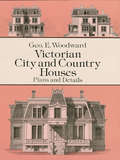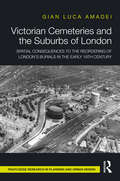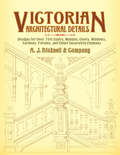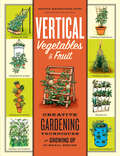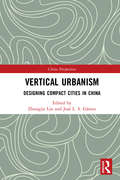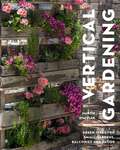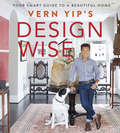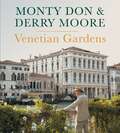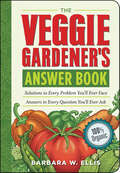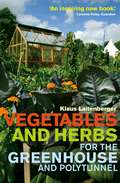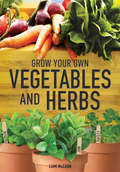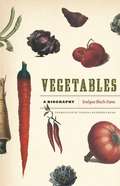- Table View
- List View
Victorian City and Country Houses: Plans and Details
by Geo E. WoodwardThe widespread interest in constructing and restoring Victorian homes makes this a must-have volume for today's builders, homeowners, architects, and preservationists. It offers an abundance of authentic, finely detailed plans and designs for a variety of Victorian residences.Included are 100 front and side elevations, floor plans, and original designs -- all to working scale -- for a block of five city houses, a country house with a French roof, a summer house, various styles of cottages, a tool house, and other buildings. The plates also depict a wealth of details: roof and dormer windows, balustrades, iron fences and gates, finials, crestings, gables, brackets, paneling, mantels, front doors, an oriel window, chimneys, and many other elements.Republished directly from a rare 1877 edition, the book offers a wonderfully authentic look back to the distinctive building styles of the Victorian period. It will not only delight builders and restorationists, but any student or lover of period architecture.
Victorian Cemeteries and the Suburbs of London: Spatial Consequences to the Reordering of London’s Burials in the Early 19th Century
by Gian Luca AmadeiThis book explores how Victorian cemeteries were the direct result of the socio-cultural, economic and political context of the city, and were part of a unique transformation process that emerged in London at the time. The book shows how the re-ordering of the city’s burial spaces, along with the principles of health and hygiene, were directly associated with liberal capital investments, which had consequences in the spatial arrangement of London. Victorian cemeteries, in particular, were not only a solution for overcrowded graveyards, they also acted as urban generators in the formation London’s suburbs in the nineteenth century. Beginning with an analysis of the conditions that triggered the introduction of the early Victorian cemeteries in London, this book investigates their spatial arrangement, aesthetics and functions. These developments are illustrated through the study of three private Victorian burial sites: Kensal Green Cemetery, Highgate Cemetery and Brookwood Cemetery. The book is aimed at students and researchers of London history, planning and environment, and Victorian and death culture studies.
Victorian Cemeteries and the Suburbs of London: Spatial Consequences to the Reordering of London’s Burials in the Early 19th Century
by Gian Luca AmadeiThis book explores how Victorian cemeteries were the direct result of the socio-cultural, economic and political context of the city, and were part of a unique transformation process that emerged in London at the time. The book shows how the re-ordering of the city’s burial spaces, along with the principles of health and hygiene, were directly associated with liberal capital investments, which had consequences in the spatial arrangement of London. Victorian cemeteries, in particular, were not only a solution for overcrowded graveyards, they also acted as urban generators in the formation London’s suburbs in the nineteenth century. Beginning with an analysis of the conditions that triggered the introduction of the early Victorian cemeteries in London, this book investigates their spatial arrangement, aesthetics and functions. These developments are illustrated through the study of three private Victorian burial sites: Kensal Green Cemetery, Highgate Cemetery and Brookwood Cemetery. The book is aimed at students and researchers of London history, planning and environment, and Victorian and death culture studies.
Victorian Architectural Details: Designs for Over 700 Stairs, Mantels, Doors, Windows, Cornices, Porches, and Other Decorative Elements
by A. J. Bicknell Co.Hundreds of rare illustrations depict wide range of design alternatives for prospective homeowners and other customers of the late 19th century. While the collection includes elevations and floor plans for a variety of handsome, private residences and commercial structures, the emphasis is on architectural details — from dormer windows to balconies.
Vickery's Folk Flora: An A-Z of the Folklore and Uses of British and Irish Plants
by Roy VickeryThis book is a dictionary of British (native, naturalised and cultivated) plants and the folklore associated with them. Unlike many plant-lore publications Vickery's Folk Flora tells us what people currently do and believe, rather than what Victorians did and believed. The result is a vivid demonstration that plant folklore in the British Isles is not only surviving but flourishing; adapting and evolving as time goes by, even in urban areas.Each entry includes:- The plant's English and scientific (Latin) name, as well as significant local names.- A brief description of the plant and its distribution, and, in the case of cultivated plants, a history of their introduction to the British Isles- Information on the folklore and traditional uses of the plant, arranged where possible in a sequence starting with general folk beliefs (superstitions), use in traditional customs, use in folk medicine, other uses, and legends concerning individual representatives of the plant.In addition to the major entries there are a number of minor entries for feast days, diseases and other subjects which direct readers to relevant major entries, e.g. St. George's Day, on which red roses are worn; dandelions are gathered; and runner beans are planted.
Vertical Vegetables & Fruit: Creative Gardening Techniques for Growing Up in Small Spaces
by Rhonda Massingham HartGet big results from small growing spaces with this guide to creating low-maintenance, high-yield vertical gardens.
Vertical Urbanism: Designing Compact Cities in China (China Perspectives)
by Zhongjie Lin José L. S. GámezStudies of compact cities have evolved along with the rising awareness of climate change and sustainable development. Relevant debates, however, reveal that the prevailing definitions and practices of compact cities are tied primarily to traditional Western urban forms. This book reinterprets "compact city", and develops a ground-breaking discourse of "Vertical Urbanism", a concept that has never been critically articulated. It emphasizes "Vertical Urbanism" as a dynamic design strategy instead of a static form, distinguishing it from the stereotyped concept of "vertical city" or "towers in the park" dominant in China and elsewhere, and suggests its adaptability to different geographic and cultural contexts. Using Chinese cities as laboratories of investigation, this book explores the design, ecological, and sociocultural dimensions of building compact cities, and addresses important global urban issues through localized design solutions, such as the relationship between density and vitality, the integration of horizontal and vertical dimensions of design, and the ecological and social adaptability of combinatory mega-forms. In addition, through discussions with scholars from the United States, China, and Japan, this book provides an insight into the theoretical debates surrounding "compact city" and "Vertical Urbanism" in the global context. Scholars and students in architecture and urban planning will be attracted by this book. Also, it will appeal to readers with an interest in urban development and Asian studies.
Vertical Urbanism: Designing Compact Cities in China (China Perspectives)
by Zhongjie Lin José L. S. GámezStudies of compact cities have evolved along with the rising awareness of climate change and sustainable development. Relevant debates, however, reveal that the prevailing definitions and practices of compact cities are tied primarily to traditional Western urban forms. This book reinterprets "compact city", and develops a ground-breaking discourse of "Vertical Urbanism", a concept that has never been critically articulated. It emphasizes "Vertical Urbanism" as a dynamic design strategy instead of a static form, distinguishing it from the stereotyped concept of "vertical city" or "towers in the park" dominant in China and elsewhere, and suggests its adaptability to different geographic and cultural contexts. Using Chinese cities as laboratories of investigation, this book explores the design, ecological, and sociocultural dimensions of building compact cities, and addresses important global urban issues through localized design solutions, such as the relationship between density and vitality, the integration of horizontal and vertical dimensions of design, and the ecological and social adaptability of combinatory mega-forms. In addition, through discussions with scholars from the United States, China, and Japan, this book provides an insight into the theoretical debates surrounding "compact city" and "Vertical Urbanism" in the global context. Scholars and students in architecture and urban planning will be attracted by this book. Also, it will appeal to readers with an interest in urban development and Asian studies.
The Vertical Man: A Study in Primitive Indian Sculpture (Routledge Revivals)
by W.G. ArcherOriginally published in 1947, The Vertical Man explores a form of Indian sculpture largely ignored in other studies, with a focus on two kinds of sculpture from the province of Bihar. The book provides detailed analysis of the formal characteristics of the sculpture and the influences of the myth, ritual, and context in which they were commissioned and made. It explains why the sculpture is regional and "why the styles are what they are". It is an original study which throws light on important subjects such as the relations of art and religion and of art and economics. The Vertical Man will appeal to those with an interest in art, specifically sculpture and the art of the Indian countryside.
The Vertical Man: A Study in Primitive Indian Sculpture (Routledge Revivals)
by W.G. ArcherOriginally published in 1947, The Vertical Man explores a form of Indian sculpture largely ignored in other studies, with a focus on two kinds of sculpture from the province of Bihar. The book provides detailed analysis of the formal characteristics of the sculpture and the influences of the myth, ritual, and context in which they were commissioned and made. It explains why the sculpture is regional and "why the styles are what they are". It is an original study which throws light on important subjects such as the relations of art and religion and of art and economics. The Vertical Man will appeal to those with an interest in art, specifically sculpture and the art of the Indian countryside.
Vertical Gardening: Green ideas for small gardens, balconies and patios
by Martin StafflerWith low-cost and sustainable DIY projects, this practical guide helps gardeners to make use of small spaces by growing upwards. Vertical gardening offers great opportunities to grow flowers, vegetables, succulents and herbs, particularly for those with a balcony, patio or compact garden. It can also be a fantastic way to showcase creative and sustainable design choices, whether you've got wood, terracotta pots, burlap sacks, fabric or even plastic bottles. From privacy screens to foldable storage, this helpful guide includes step-by-step DIY projects, plant care tips and tricks, and practical information on the special challenges that come with planting in a compact garden, including advice on pests, drainage and plants suited for gardens with limited light. Beautifully illustrated throughout with aspirational photography and useful diagrams, Vertical Gardening celebrates the versatility of growing up in a small or awkward space.
Vertical Gardening: Green ideas for small gardens, balconies and patios
by Martin StafflerWith low-cost and sustainable DIY projects, this practical guide helps gardeners to make use of small spaces by growing upwards. Vertical gardening offers great opportunities to grow flowers, vegetables, succulents and herbs, particularly for those with a balcony, patio or compact garden. It can also be a fantastic way to showcase creative and sustainable design choices, whether you've got wood, terracotta pots, burlap sacks, fabric or even plastic bottles. From privacy screens to foldable storage, this helpful guide includes step-by-step DIY projects, plant care tips and tricks, and practical information on the special challenges that come with planting in a compact garden, including advice on pests, drainage and plants suited for gardens with limited light. Beautifully illustrated throughout with aspirational photography and useful diagrams, Vertical Gardening celebrates the versatility of growing up in a small or awkward space.
The Versailles Effect: Objects, Lives, and Afterlives of the Domaine (Material Culture of Art and Design)
by Mark Ledbury and Robert WellingtonThe essays in this volume show that Versailles was not the static creation of one man, but a hugely complex cultural space; a centre of power, but also of life, love, anxiety, creation, and an enduring palimpsest of aspirations, desires, and ruptures. The splendour of the Château and the masterpieces of art and design that it contains mask a more complex and sometimes more sordid history of human struggle and achievement. The case studies presented by the contributors to this book cannot provide a comprehensive account of the Palace of Versailles and its domains, the life within its walls, its visitors, and the art and architecture that it has inspired from the seventeenth century to the present day: from the palace of the Sun King to the Penthouse of Donald Trump. However, this innovative collection will reshape-or even radically redefine-our understanding of the palace of Versailles and its posterity.
The Versailles Effect: Objects, Lives, and Afterlives of the Domaine (Material Culture of Art and Design)
The essays in this volume show that Versailles was not the static creation of one man, but a hugely complex cultural space; a centre of power, but also of life, love, anxiety, creation, and an enduring palimpsest of aspirations, desires, and ruptures. The splendour of the Château and the masterpieces of art and design that it contains mask a more complex and sometimes more sordid history of human struggle and achievement. The case studies presented by the contributors to this book cannot provide a comprehensive account of the Palace of Versailles and its domains, the life within its walls, its visitors, and the art and architecture that it has inspired from the seventeenth century to the present day: from the palace of the Sun King to the Penthouse of Donald Trump. However, this innovative collection will reshape-or even radically redefine-our understanding of the palace of Versailles and its posterity.
Vern Yip's Design Wise: Your Smart Guide to a Beautiful Home
by Vern YipHGTV and Trading Spaces' trusted interior designer Vern Yip shares his favorite design secrets to creating living spaces that have flow, balance, and harmony--while opening his doors to show how he's made these principles work in his own beloved homes. This New York Times bestseller provides both the inspiration and the clear, essential guidelines you need to create a home that perfectly reflects you. Have you ever wondered exactly how high to hang your artwork? How about the light fixture over your dining table? Do you know how to ideally size a rug for any room, or the best way to arrange your furniture? Beloved designer Vern Yip answers these questions, and more, by revealing the right formulas and measurements that can make any room feel just "right." And once you know these key design principles, you're free to confidently create a home that uniquely celebrates your needs and style. With gorgeous photos throughout, Vern Yip's Design Wise is a book you'll return to again and again.
Venetian Gardens
by Monty Don Derry MooreJoin Monty Don, Britain's pre-eminent gardener, and acclaimed photographer Derry Moore on their historic journey through the most stunning gardens of Venice and the Veneto.Few world cities hold the romance and historical sweep of Venice. Thousands visit every year - and a mixture of crowds and climate leave it vulnerable, so much so it is often said to be in danger of sinking - but away from the usual tourist haunts around St. Mark's square are exceptional hidden treasures, some 500 gardens, many of them with fascinating stories.Starting in the heart of the city and working their way out to the Veneto, Monty and Derry celebrate the beauty of these places and tell their unique stories: from a beautiful nunnery garden with a history of exotic animals and a kitchen garden of the historic Foundation to the Madonna church to the estates of famous Venetian families, like the spectacular Giusti Renaissance garden.With stunning full colour photography throughout, Venice Gardens will give readers new insight into one of the world's most beloved cities - you won't see Venice the same way again.
The Veggie Gardener's Answer Book: Solutions to Every Problem You'll Ever Face; Answers to Every Question You'll Ever Ask
by Barbara W. EllisBarbara Ellis provides expert answers for all of your toughest vegetable-growing questions. Designed to be used as an in-the-garden reference, this sturdy little volume is packed with helpful information on everything from planning a garden and sowing seeds to battling pests and harvesting organic crops. With clever tricks to cut down on weed growth, secrets for maximizing production in confined growing spaces, and fail-safe watering guidelines, you&’ll have the know-how and inspiration to grow your most abundant vegetable garden ever.
Vegetables and Herbs for the Greenhouse and Polytunnel
by Klaus LaitenbergerWith our unpredictable weather, there's never been a better time to cultivate vegetables under shelter. Experienced grower, Klaus Laitenberger shows how to use the heat and shelter of a greenhouse or polytunnel to maximise crop production and supply tasty, healthy food throughout the year. He gives full details of sowing, planting, spacing and harvesting for all our best-loved herbs and vegetables, as well as introducing exotic newcomers such as pepino and yacon.
Vegetables and Herbs
by Liam McCannGrowing vegetables and herbs at home is easy and rewarding as long as you choose the best time to plant the right seeds. Some require a little TLC while others will happily look after themselves.You don’t need to tend a dedicated area in your garden as most vegetables herbs will thrive next to flowers or in containers on balconies or windowsills, or preferably in a plot or on an allotment.This informative little ebook looks at the origins and history of many of the world’s most popular vegetables herbs as well as teaching you the best way to grow them.
Vegetables: A Biography
by Evelyne Bloch-DanoFrom Michael Pollan to locavores, Whole Foods to farmers' markets, today cooks and foodies alike are paying more attention than ever before to the history of the food they bring into their kitchens—and especially to vegetables. Whether it’s an heirloom tomato, curled cabbage, or succulent squash, from a farmers' market or a backyard plot, the humble vegetable offers more than just nutrition—it also represents a link with long tradition of farming and gardening, nurturing and breeding. In this charming new book, those veggies finally get their due. In capsule biographies of eleven different vegetables—artichokes, beans, chard, cabbage, cardoons, carrots, chili peppers, Jerusalem artichokes, peas, pumpkins, and tomatoes—Evelyne Bloch-Dano explores the world of vegetables in all its facets, from science and agriculture to history, culture, and, of course, cooking. From the importance of peppers in early international trade to the most recent findings in genetics, from the cultural cachet of cabbage to Proust’s devotion to beef-and-carrot stew, to the surprising array of vegetables that preceded the pumpkin as the avatar of All Hallow’s Eve, Bloch-Dano takes readers on a dazzling tour of the fascinating stories behind our daily repasts. Spicing her cornucopia with an eye for anecdote and a ready wit, Bloch-Dano has created a feast that’s sure to satisfy gardeners, chefs, and eaters alike.
Vegetables: A Biography
by Evelyne Bloch-DanoFrom Michael Pollan to locavores, Whole Foods to farmers' markets, today cooks and foodies alike are paying more attention than ever before to the history of the food they bring into their kitchens—and especially to vegetables. Whether it’s an heirloom tomato, curled cabbage, or succulent squash, from a farmers' market or a backyard plot, the humble vegetable offers more than just nutrition—it also represents a link with long tradition of farming and gardening, nurturing and breeding. In this charming new book, those veggies finally get their due. In capsule biographies of eleven different vegetables—artichokes, beans, chard, cabbage, cardoons, carrots, chili peppers, Jerusalem artichokes, peas, pumpkins, and tomatoes—Evelyne Bloch-Dano explores the world of vegetables in all its facets, from science and agriculture to history, culture, and, of course, cooking. From the importance of peppers in early international trade to the most recent findings in genetics, from the cultural cachet of cabbage to Proust’s devotion to beef-and-carrot stew, to the surprising array of vegetables that preceded the pumpkin as the avatar of All Hallow’s Eve, Bloch-Dano takes readers on a dazzling tour of the fascinating stories behind our daily repasts. Spicing her cornucopia with an eye for anecdote and a ready wit, Bloch-Dano has created a feast that’s sure to satisfy gardeners, chefs, and eaters alike.
Vegetables: A Biography
by Evelyne Bloch-DanoFrom Michael Pollan to locavores, Whole Foods to farmers' markets, today cooks and foodies alike are paying more attention than ever before to the history of the food they bring into their kitchens—and especially to vegetables. Whether it’s an heirloom tomato, curled cabbage, or succulent squash, from a farmers' market or a backyard plot, the humble vegetable offers more than just nutrition—it also represents a link with long tradition of farming and gardening, nurturing and breeding. In this charming new book, those veggies finally get their due. In capsule biographies of eleven different vegetables—artichokes, beans, chard, cabbage, cardoons, carrots, chili peppers, Jerusalem artichokes, peas, pumpkins, and tomatoes—Evelyne Bloch-Dano explores the world of vegetables in all its facets, from science and agriculture to history, culture, and, of course, cooking. From the importance of peppers in early international trade to the most recent findings in genetics, from the cultural cachet of cabbage to Proust’s devotion to beef-and-carrot stew, to the surprising array of vegetables that preceded the pumpkin as the avatar of All Hallow’s Eve, Bloch-Dano takes readers on a dazzling tour of the fascinating stories behind our daily repasts. Spicing her cornucopia with an eye for anecdote and a ready wit, Bloch-Dano has created a feast that’s sure to satisfy gardeners, chefs, and eaters alike.
Vegetables: A Biography
by Evelyne Bloch-DanoFrom Michael Pollan to locavores, Whole Foods to farmers' markets, today cooks and foodies alike are paying more attention than ever before to the history of the food they bring into their kitchens—and especially to vegetables. Whether it’s an heirloom tomato, curled cabbage, or succulent squash, from a farmers' market or a backyard plot, the humble vegetable offers more than just nutrition—it also represents a link with long tradition of farming and gardening, nurturing and breeding. In this charming new book, those veggies finally get their due. In capsule biographies of eleven different vegetables—artichokes, beans, chard, cabbage, cardoons, carrots, chili peppers, Jerusalem artichokes, peas, pumpkins, and tomatoes—Evelyne Bloch-Dano explores the world of vegetables in all its facets, from science and agriculture to history, culture, and, of course, cooking. From the importance of peppers in early international trade to the most recent findings in genetics, from the cultural cachet of cabbage to Proust’s devotion to beef-and-carrot stew, to the surprising array of vegetables that preceded the pumpkin as the avatar of All Hallow’s Eve, Bloch-Dano takes readers on a dazzling tour of the fascinating stories behind our daily repasts. Spicing her cornucopia with an eye for anecdote and a ready wit, Bloch-Dano has created a feast that’s sure to satisfy gardeners, chefs, and eaters alike.
Vegetables: A Biography
by Evelyne Bloch-DanoFrom Michael Pollan to locavores, Whole Foods to farmers' markets, today cooks and foodies alike are paying more attention than ever before to the history of the food they bring into their kitchens—and especially to vegetables. Whether it’s an heirloom tomato, curled cabbage, or succulent squash, from a farmers' market or a backyard plot, the humble vegetable offers more than just nutrition—it also represents a link with long tradition of farming and gardening, nurturing and breeding. In this charming new book, those veggies finally get their due. In capsule biographies of eleven different vegetables—artichokes, beans, chard, cabbage, cardoons, carrots, chili peppers, Jerusalem artichokes, peas, pumpkins, and tomatoes—Evelyne Bloch-Dano explores the world of vegetables in all its facets, from science and agriculture to history, culture, and, of course, cooking. From the importance of peppers in early international trade to the most recent findings in genetics, from the cultural cachet of cabbage to Proust’s devotion to beef-and-carrot stew, to the surprising array of vegetables that preceded the pumpkin as the avatar of All Hallow’s Eve, Bloch-Dano takes readers on a dazzling tour of the fascinating stories behind our daily repasts. Spicing her cornucopia with an eye for anecdote and a ready wit, Bloch-Dano has created a feast that’s sure to satisfy gardeners, chefs, and eaters alike.
Vegetables: A Biography
by Evelyne Bloch-DanoFrom Michael Pollan to locavores, Whole Foods to farmers' markets, today cooks and foodies alike are paying more attention than ever before to the history of the food they bring into their kitchens—and especially to vegetables. Whether it’s an heirloom tomato, curled cabbage, or succulent squash, from a farmers' market or a backyard plot, the humble vegetable offers more than just nutrition—it also represents a link with long tradition of farming and gardening, nurturing and breeding. In this charming new book, those veggies finally get their due. In capsule biographies of eleven different vegetables—artichokes, beans, chard, cabbage, cardoons, carrots, chili peppers, Jerusalem artichokes, peas, pumpkins, and tomatoes—Evelyne Bloch-Dano explores the world of vegetables in all its facets, from science and agriculture to history, culture, and, of course, cooking. From the importance of peppers in early international trade to the most recent findings in genetics, from the cultural cachet of cabbage to Proust’s devotion to beef-and-carrot stew, to the surprising array of vegetables that preceded the pumpkin as the avatar of All Hallow’s Eve, Bloch-Dano takes readers on a dazzling tour of the fascinating stories behind our daily repasts. Spicing her cornucopia with an eye for anecdote and a ready wit, Bloch-Dano has created a feast that’s sure to satisfy gardeners, chefs, and eaters alike.
